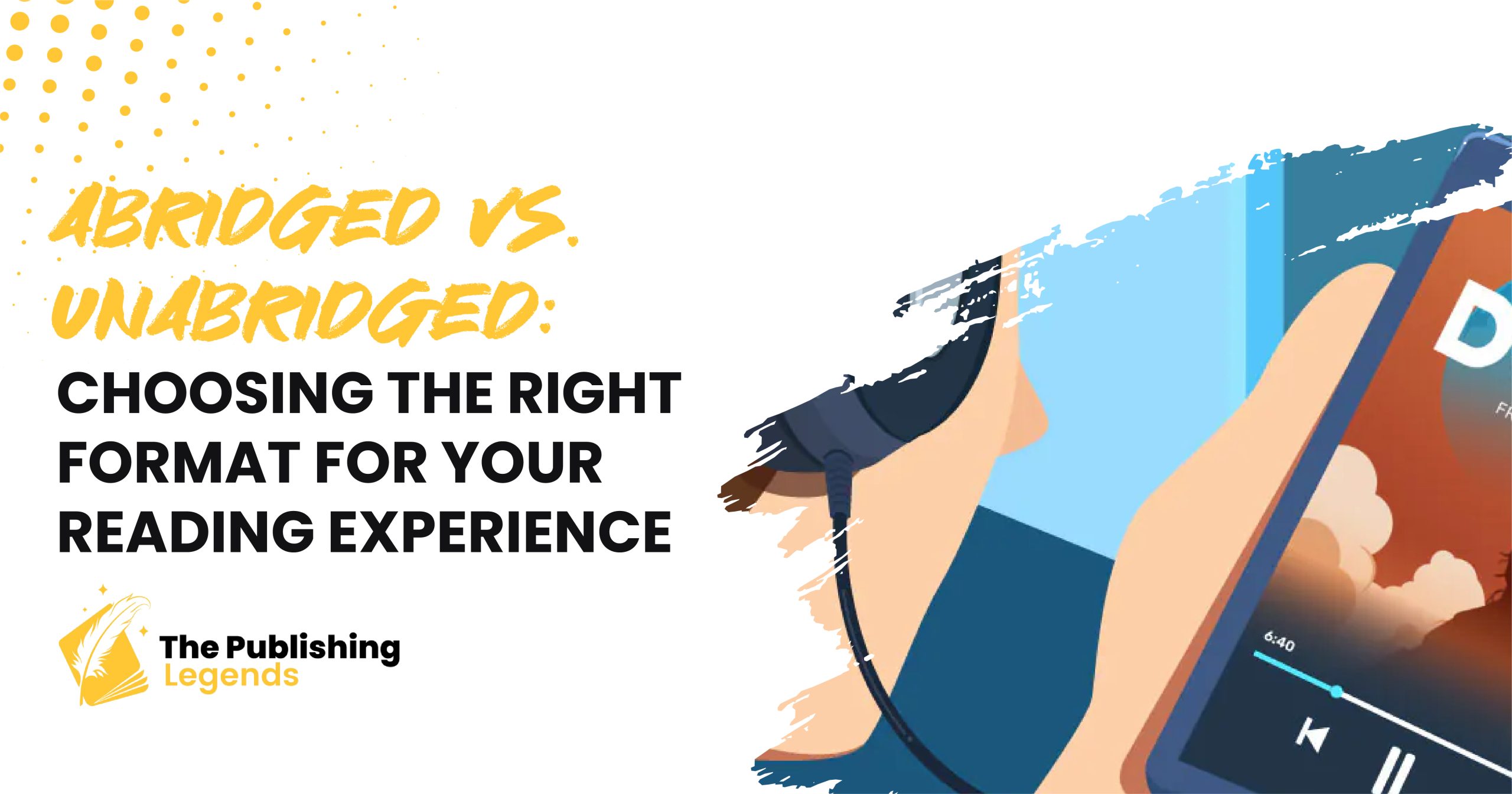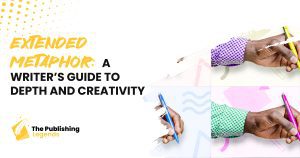A little label in publishing will transform how a story goes to its reader. The words a book is described as abridged and unabridged may sound like matter-of-fact labels, but they often influence the pace, your tone, and even the emotional connection you take with a book. Personally, you may have come across this difference by completing an audiobook faster than you thought you would, or pulling one of the many versions of a classic and finding yourself not understanding why one of them seems slimmer.
These two terms still elude many authors and readers, and we spend much of our time disentangling them at The Publishing Legends. That distinction is not merely in length. It has to do with the type of trip you prefer: a leaner route that keeps only what is necessary, or the complete terrain where texture and digressions count. Such awareness of implications helps you to decide what edition you want for yourself, when you want it, and why you want it.
What “Abridged” Actually Means
The abridged version is the purposeful reduction of the original. Editors may, with or without the authors or rights holders, cut digressions, longer descriptions, tedious repetition of a motif, secondary subplots, and keep the essential narrative or argument. When the form, which I call an abridgment, is well performed, the reader cannot guess where a character begins or where one ends or that there were any changes; the form, you see, is continuous. It is not to rewrite, but to trim, with some discretion.
In the broadcast medium, abridgment could reduce an audio program originating over a fifteen-hour block to eight or ten hours. When in print, a book that consists of five hundred pages might end up with three hundred and fifty. The overview remains to provide the primary plot or thesis line, the key characters or concepts, and the key beats that characterize the work.
Want help choosing the right format for your next release? Explore our Book Formatting Services – clarity and customization built for every reader.
What “Unabridged” Promises
Unabridged means you get the work as it was published. Every scene, aside, footnote, and turn of phrase. Nothing is omitted for length. For many readers, this is a matter of principle: if you want the author’s full artistic design, you pick unabridged. It’s also a practical choice for anyone who needs precise citations, historical nuance, or the complete accumulation of motifs that make a novel or argument land with its intended weight. The pace may be slower and the commitment larger, but the reward is fidelity: you experience the author’s voice without intermediaries deciding which parts to omit.
Why the Distinction Exists
The purpose of abridgment came about due to reasons of access. Long books are taxing, and not all readers have the time and bandwidth to go all the way through. Others desire a shorter route to the nucleus of a tale; most audiences prefer to complete a book in the course of 1 week of commuter experience instead of a month. Shortened texts are very well known in the educational field as stepping blocks to language learners or younger readers who might otherwise be put off by length or density.
Then there are practical limits too. Audio recording is costly, and long recordings translate to extensive time in the studio, bigger files, and larger expenditures. Libraries and bookstores are trying to balance budget and space. A shortened audio will make a high-profile title accessible to a platform or enable a library to provide more copies of a popular work. Abbreviation is also a tactic that can serve the supply, demand, and access.
How the Experience Differs for Readers
Pace is the most obvious difference. An abridged edition often moves with the tautness of film, prioritizing plot points or main arguments over scenic detail. That can feel thrilling and clean. But what you gain in velocity, you may lose in atmosphere. Unabridged reading lets motifs accumulate and characters mature on the page. Extended descriptions, eccentric dialogue, and seemingly minor detours build tone, meaning, and stakes. If you love to linger in a writer’s sentences, unabridged will likely feel richer. If you prefer an efficient experience that hits the major beats without the embroidery, abridged can be ideal.
There is also a cognitive effect. Condensed texts reduce the number of breadcrumbs your memory must track, which can make a complex topic easier to grasp on a first pass. Full texts, by contrast, offer redundancy and reinforcement: the author repeats images, varies examples, and circles back through themes. Choosing between formats is partly a decision about how you best absorb information.
Audiobooks and the Abridgment Question
Audiobooks magnify the trade-off because time is concrete in audio and the narrator’s performance becomes part of the art. Abridged audio can sharpen pacing and hold attention in shorter listening windows, which is great for commutes, workouts, or household tasks. Trimming digressions can also reduce listener fatigue in dense nonfiction. When done with care, an abridged performance is crisp and engaging, like a well-edited documentary.
Yet cutting material sometimes interrupts character development or foreshadowing that a skilled narrator would have elevated. Unabridged audio lets the performance breathe; pauses, cadence, and timbre mirror the author’s rhythm and create emotional continuity. If a book’s voice is one of its pleasures, unabridged audio is usually worth the extra hours. Many listeners find that a narrator’s rendering of humor, subtext, or tension only fully lands when the connective tissue remains intact.
Not sure which format suits your next release? Talk to our book publishing experts and get personalized guidance on choosing between abridged and unabridged editions.
Education, Study, and Citations
In classrooms and research, unabridged tends not to be an option. You require the text per se when you examine themes, follow a symbol, or cite a passage. Even minor slashes can change the meaning. Any one paragraph deleted can alter the motivation of a character, or close the line of argument of a historian. That is why syllabi and reading lists on exams almost always indicate unabridged when it comes to primary reading and core sources.
It does not imply that abridged versions can have no role in education. They could be used as a scaffolding, pre-reading aids that give a picture before the entire work is undertaken. Occasionally, teachers will start with an abridged adaptation, which is used to develop confidence and transfer students into the original to develop understanding. The key is transparency: students should always know which version they are reading and why that choice was made at that moment in their learning.
What Authors and Publishers Weigh
From the creator side, abridging a work for audio or for special programs can broaden reach without diluting the flagship edition. Authors who write dense, research-heavy books may authorize an abridged audiobook for commuters while keeping the print and e-book unabridged. The choice intersects with branding: some authors prize the completeness of their voice and never abridge; others embrace multiple entry points to the same ideas. Publishers weigh rights complexity, narrator availability, audience demand, and the economics of producing parallel editions. When it’s done thoughtfully, offering both formats is a reader-first strategy.
Misconceptions to Avoid
One misconception is that abridged editions are “lesser” and therefore not worth reading. Quality varies, but a careful abridgment can be elegant and genuinely useful. Another misconception is that unabridged editions are automatically harder; often they are simply longer. Difficulty depends more on the author’s style and your familiarity with the subject than on page count. A third misconception is that abridged must mean simplified language. In many adult editions, the language remains sophisticated; the difference is scope, not vocabulary. The most important truth is that both formats have legitimate roles, and both can deliver a rewarding experience when chosen intentionally.
Examples That Illustrate the Choice
Think of a vast historical epic that would span across continents and interweave two families and two timelines. There is a full sweep–maps, family trees, letters, which you will not find here unless you want it unabridged. An abridged audio version may allow you to play along even though your book club has selected it, and you are new to the group. So now look at a management classic worth remembering. The shortened version could convey the frameworks as concisely as possible, whereas the non-abridged version would elaborate on the frameworks by establishing the case studies, contrasting them with counter-examples, and exploring the origin stories that cause the ideas to stick. Neither is wrong; each is used with a different reading objective.
Ethics and Expectations
Clarity is what the readers need. Marketing among books should not put the impression that a shortened or abridged edition is the definitive text of any book, and labels must stand out. In the same way, when talking about a book, reviewers and educators ought to provide which version they were guided by. Openness safeguards the faith. Morally, the editor should not cross over the line of ethics, such as using illegible or imperfect cuts; they undermine the piece as the voice of the author. Our editorial policy is as follows: At The Publishing Legends, we advocate empowerment of choice by providing honest information and clean labels.
For Authors Considering an Abridged Path
As an author considering an abridgment on audio or a summarized edition, it is best to start with the purpose. Who is the second audience that will be addressed by an abridgment? What do we have to keep to maintain integrity? Prepare an abridgment brief that will include those scenes or sections that are not negotiable, as well as tonal guardrails and terminology to be retained. Select an editor who loves your rhythm and a narrator who can deliver innuendo even with a quicker rate. See the abridged as a cousin, not an alternative: annotate to the unabridged in the pre-front material, and say you can look at a more complete piece of the work should they desire it.
The Bottom Line
“Abridged vs. unabridged” is not a value judgment; it’s a choice of experience. Unabridged preserves totality and depth. Abridged offers momentum and access. The right decision depends on purpose, context, and the kind of reader you are this week. As long as the edition is clearly labeled and respectfully produced, both formats enrich the ecosystem of reading.
Ready to publish with clarity and impact? Partner with The Publishing Legends and let us help you craft and label your editions with integrity.




